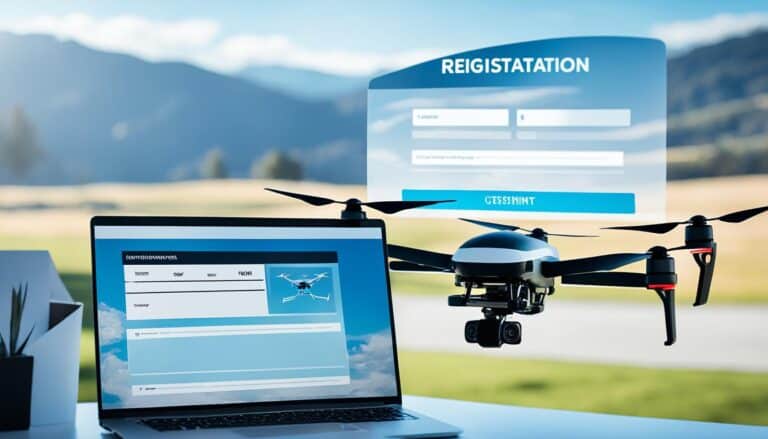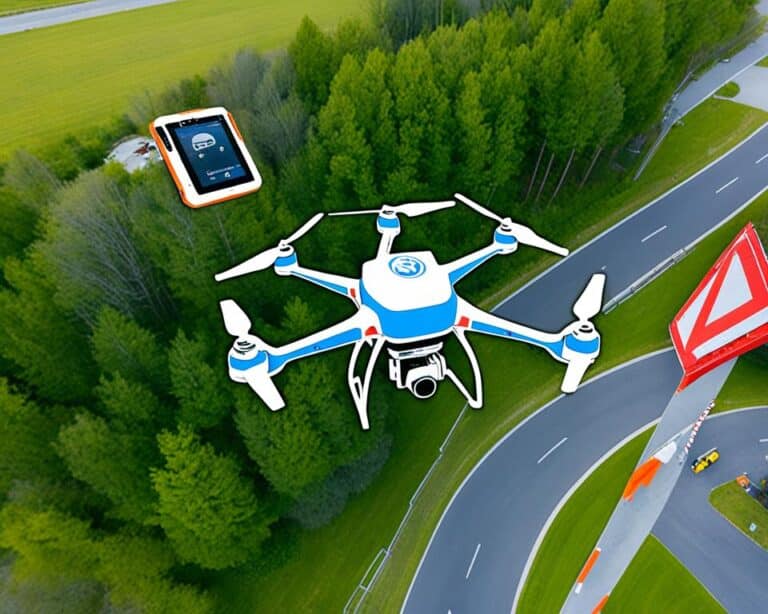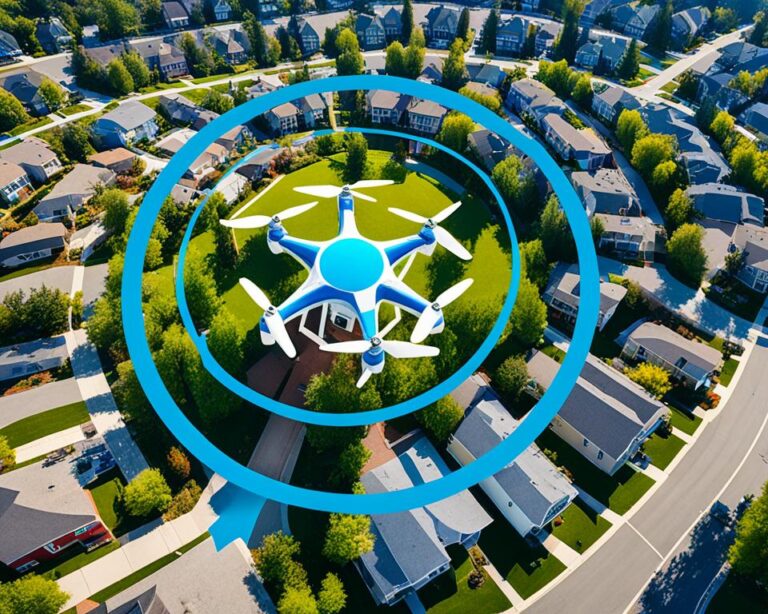Drone Weight Limit Requirements for Pilots in America
Flying unmanned aircraft in the United States requires understanding specific regulations that govern your operations. The Federal Aviation Administration has created clear guidelines that every pilot must follow. These rules help ensure safe skies for everyone.
Your aircraft’s mass directly impacts what certifications you need and how you can operate legally. Understanding the drone weight limit for license requirements prevents costly violations. It also helps you choose the right equipment for your missions.
Whether you fly recreationally or commercially, knowing federal requirements is essential. This guide covers everything from basic FAA drone registration to advanced pilot certifications. You’ll learn exactly what documentation your aircraft needs and when you need additional training.
Key Takeaways
- Aircraft under 0.55 pounds don’t require registration with aviation authorities
- Recreational pilots need different certifications than commercial operators
- Mass categories determine your operational restrictions and flight permissions
- Registration must be completed before your first flight in most cases
- Commercial operations require additional testing and documentation
- Penalties for non-compliance can include fines up to $27,500
Understanding FAA Drone Weight Categories and Their Impact on Pilots
Understanding drone weight classifications is essential for every pilot operating unmanned aircraft systems in United States airspace. The FAA has developed these drone weight categories based on scientific risk assessments and real-world safety data.
The classification system isn’t random. It reflects the potential danger each weight class poses to people on the ground, property, and manned aircraft. Your drone’s weight determines your entire regulatory pathway.
Micro drones under 0.55 pounds represent the lowest risk category. These lightweight aircraft require minimal oversight because their small size limits potential damage. Most toy drones and basic camera models fall into this range.
The small unmanned aircraft systems (sUAS) category spans 0.55 to 55 pounds. This range covers most consumer and commercial drones. Pilots operating aircraft in this weight class need registration and often require Part 107 certification for commercial operations.
Aircraft exceeding 55 pounds enter specialized territory. These larger systems need special airworthiness certificates and extensive pilot qualifications. The regulatory requirements become significantly more complex.
Your drone’s weight directly affects three critical areas: registration requirements, pilot certification needs, and operational restrictions. A single pound can shift you from recreational flying to commercial certification requirements.
Weight also determines where you can fly and what operations you can perform. Heavier aircraft face stricter altitude limits, no-fly zone restrictions, and air traffic control coordination requirements. Understanding these drone weight categories helps you choose appropriate equipment and avoid costly compliance mistakes.
The system protects both pilots and the public by matching regulatory oversight to actual risk levels. Lighter aircraft get streamlined processes, while heavier systems receive thorough scrutiny. This approach keeps recreational flying accessible while maintaining safety standards for commercial operations requiring Part 107 certification.
Drone Weight Limit for License Requirements Under Part 107
The Federal Aviation Administration’s Part 107 regulations create specific weight thresholds that determine when commercial drone pilots need certification. These rules apply to anyone using drones for business purposes, from real estate photography to agricultural monitoring.
Under Part 107, the critical weight boundary sits at 0.55 pounds. Any drone weighing this amount or more requires the pilot to hold a valid Remote Pilot Certificate for commercial operations. This requirement exists regardless of whether your drone weighs 0.55 pounds or approaches the 55-pound maximum for small unmanned aircraft systems.
The weight-based licensing system ensures that operators of potentially hazardous aircraft demonstrate sufficient knowledge to fly safely. Commercial operations carry higher risks than recreational flying, making proper certification essential for public safety.
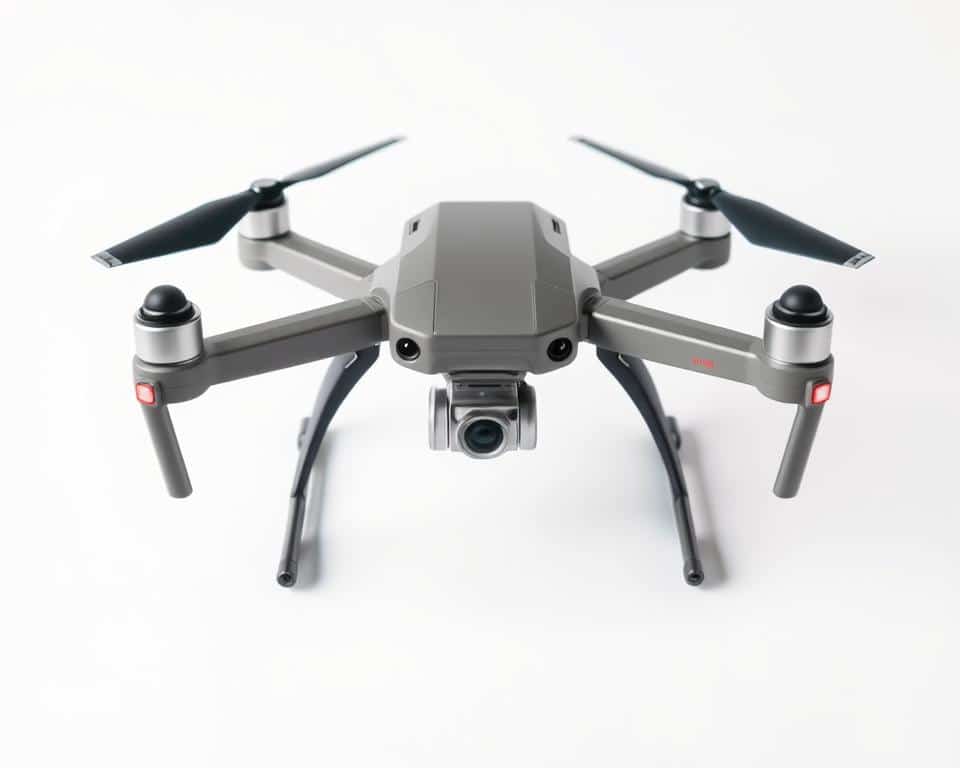
Weight Thresholds for Professional Operations
Commercial drone operations follow a straightforward weight-based certification system. Drones under 0.55 pounds can operate commercially without a commercial drone license, though other regulations still apply.
Once your drone reaches or exceeds 0.55 pounds, Part 107 certification becomes mandatory. This threshold applies to the drone’s total weight, including batteries, cameras, and any attached equipment. No exceptions exist for commercial operations above this weight limit.
The 0.55-pound threshold serves as the gateway between unregulated micro-drones and aircraft requiring professional oversight. This weight category encompasses most consumer and professional drones used in commercial applications today.
Pilots must maintain current certification throughout their commercial operations. The Remote Pilot Certificate remains valid for two years before requiring recertification through testing or online training.
Application Process for Remote Pilot Certification
Obtaining your Remote Pilot Certificate involves several key steps that demonstrate your aeronautical knowledge. The process begins with studying federal regulations, airspace requirements, weather patterns, and flight operations.
You must pass an initial aeronautical knowledge test at an FAA-approved testing center. The exam covers topics like airspace classification, weather interpretation, aircraft performance, and emergency procedures. Most testing centers charge between $150-$175 for the exam.
After passing the test, complete your application through the Integrated Airman Certification and Rating Application (IACRA) system. This online portal processes your certification request and conducts a background check through the Transportation Security Administration.
The final step involves receiving your temporary certificate electronically, followed by your permanent commercial drone license arriving by mail. While different from TRUST certification for recreational pilots, this credential authorizes all commercial drone operations under Part 107.
Recreational Drone Flying Weight Limits and TRUST Certification
The world of recreational drone flying offers unique weight-based exemptions that simplify the hobby experience. Unlike commercial operations, hobbyist pilots benefit from more relaxed regulations that encourage safe exploration of the skies. The FAA recognizes that recreational use poses different risks than commercial activities.
These weight-based categories create a tiered system of requirements. Your drone’s weight determines exactly what certifications you need to fly legally. Understanding these thresholds helps you choose the right equipment and stay compliant with federal regulations.
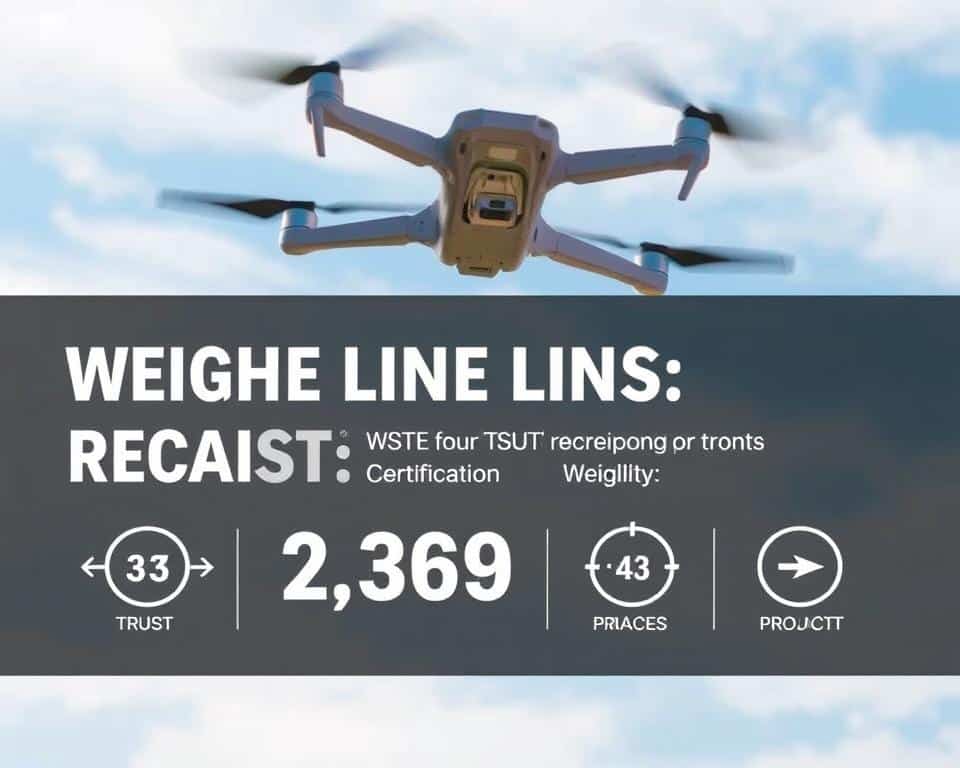
| Weight Category | Registration Required | Certification Needed | Typical Drone Types |
|---|---|---|---|
| Under 0.55 lbs | No | None | Micro drones, toy drones |
| 0.55 lbs and above | Yes | TRUST Certificate | Most consumer drones |
| Over 55 lbs | Special process | TRUST + Additional requirements | Large professional drones |
Micro Drone Freedom Under 0.55 Pounds
Drones weighing less than 0.55 pounds enjoy complete exemption from registration and certification requirements. This weight threshold recognizes that these tiny aircraft pose minimal safety risks to people and property on the ground.
Popular micro drones like small toy quadcopters fall into this category. You can fly them immediately without any paperwork or testing. However, you must still follow basic safety rules like avoiding airports and staying below 400 feet.
This exemption makes drone flying accessible to everyone, from children to seniors exploring their first aircraft.
TRUST Certification for Standard Recreational Drones
Once your recreational drone weighs 0.55 pounds or more, you must complete TRUST certification before your first flight. TRUST stands for The Recreational UAS Safety Test, a free online program that covers essential safety knowledge.
The test takes about 30 minutes to complete and covers airspace restrictions, weather considerations, and emergency procedures. You can take it from home at your own pace. Drone compliance requirements become much simpler with TRUST compared to commercial Part 107 certification.
TRUST certification ensures recreational pilots understand fundamental safety principles without creating unnecessary barriers to the hobby.
Your TRUST certificate remains valid indefinitely, though staying updated on regulation changes is always wise. This certification applies to all recreational drones weighing 0.55 pounds and above, regardless of their specific weight within that category.
FAA Registration Requirements Based on Drone Weight
The FAA has established clear registration requirements that directly correlate with your drone’s weight classification. These UAS regulations create distinct pathways for compliance based on specific weight thresholds. Understanding which category your drone falls into helps you navigate the registration process smoothly.
The registration system divides aircraft into two primary weight categories. Each category has different requirements and processes. Your drone’s total weight determines which path you must follow for legal operation.
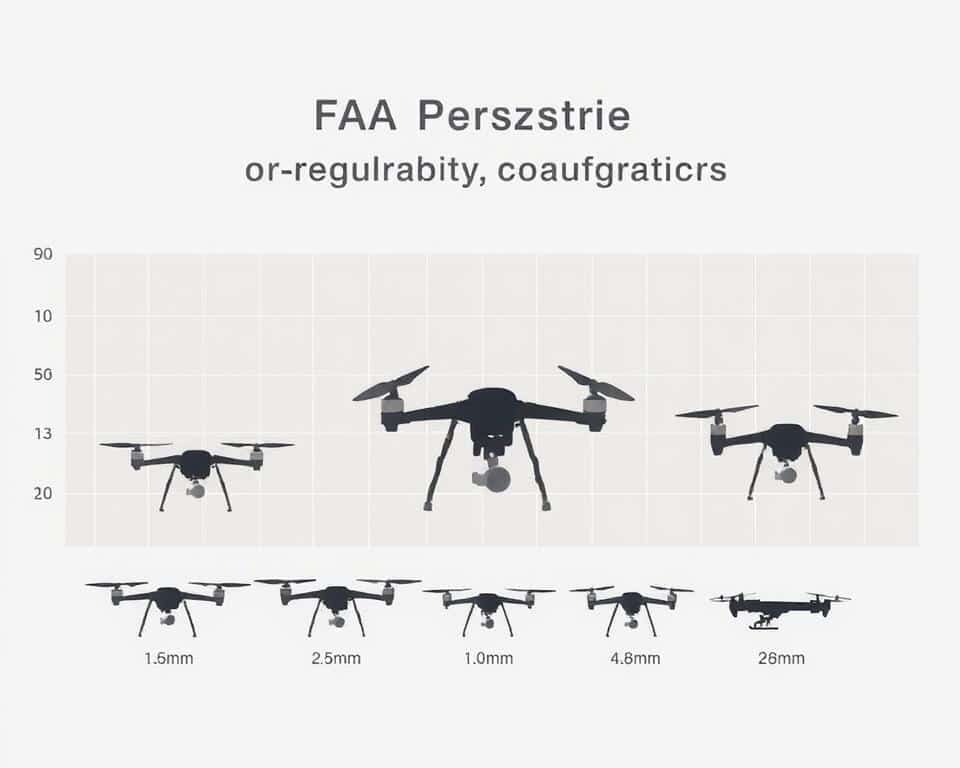
Standard Registration for Most Consumer Drones
Drones weighing between 0.55 and 55 pounds fall under the standard registration category. This covers most consumer and commercial drones available today. Popular models like DJI Mini series, Mavic drones, and professional cinematography equipment typically fit this range.
The online registration process is straightforward and affordable. You’ll pay a small fee and receive a unique registration number. This number must be clearly displayed on your aircraft before each flight.
Both recreational and commercial pilots must register drones in this weight category. The same registration applies regardless of your intended use. UAS regulations make no distinction between hobby and business operations for registration purposes.
- Complete registration online through the FAA website
- Display registration number on your drone
- Renew registration every three years
- Keep registration certificate accessible during flights
Special Requirements for Heavy Aircraft
Drones exceeding 55 pounds require special airworthiness certification instead of standard registration. These aircraft are treated more like traditional airplanes than small UAS. The certification process is significantly more complex and expensive.
Special airworthiness certification involves detailed documentation and aircraft inspection. You must prove your drone meets stringent safety and design standards. This process typically takes several months to complete.
Most pilots pursuing airworthiness certification are involved in specialized commercial operations or experimental aircraft development. The requirements include comprehensive technical documentation, flight testing data, and ongoing maintenance records.
This certification pathway is designed for serious aviation applications. It ensures heavy drones meet the same safety standards as other aircraft sharing national airspace.
Specific Weight Categories and Associated Pilot Requirements
Different drone weight categories establish unique pilot requirements based on safety considerations and operational risks. The FAA uses these weight thresholds to determine appropriate certification levels and operational restrictions. Each category reflects the potential damage and safety concerns associated with aircraft of varying sizes.
Understanding these weight-based requirements helps pilots choose the right certification path for their needs. The regulations become more complex as drone weight increases, reflecting greater safety responsibilities.
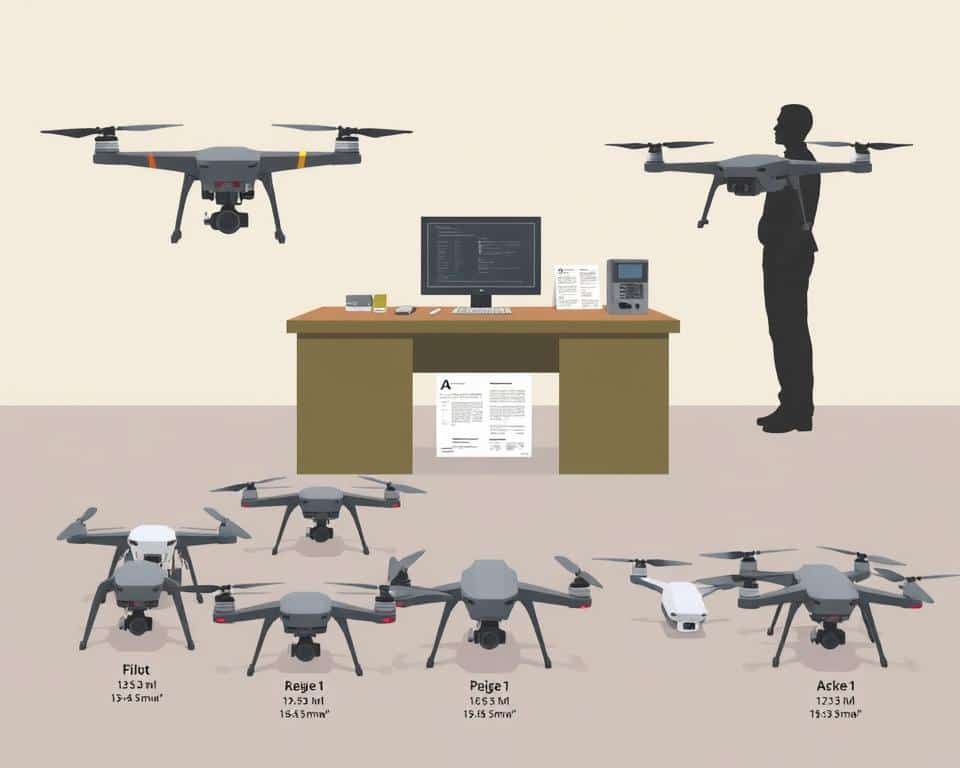
Under 0.55 Pounds: Micro Drone Regulations
Micro drone regulations offer the most relaxed requirements for recreational pilots. Drones weighing less than 0.55 pounds require no FAA registration or pilot certification for hobby use. This exemption makes micro drones accessible to beginners and casual users.
However, basic safety guidelines still apply to these lightweight aircraft. Pilots must avoid flying near airports, over people, or in restricted airspace. Even small drones can pose risks if operated carelessly around aircraft or in sensitive areas.
Commercial operations with micro drones still require Part 107 certification, regardless of weight. The FAA maintains this requirement because commercial use involves different risk factors than recreational flying.
0.55 to 25 Pounds: Standard Small UAS Category
This weight range represents the most common category for consumer and professional drones. All aircraft in this range require FAA registration, creating a baseline tracking system for drone operations. The drone pilot requirements vary significantly between commercial and recreational use within this category.
Part 107 Commercial Operations
Commercial pilots must obtain a Remote Pilot Certificate through the Part 107 examination. This certification covers airspace knowledge, weather patterns, and operational limitations. Pilots must also conduct thorough pre-flight inspections and maintain detailed flight logs.
Additional requirements include requesting airspace authorization for controlled areas and following strict operational procedures. Commercial operations demand higher safety standards due to their professional nature and potential liability issues.
Recreational Flying Requirements
Recreational pilots need TRUST certification, which involves completing an online safety course. This requirement ensures basic knowledge of safety practices and airspace restrictions. Recreational flying must stay within visual line of sight and avoid controlled airspace without prior authorization.
The recreational rules emphasize safety while maintaining accessibility for hobby pilots. These requirements balance public safety with the enjoyment of drone flying as a recreational activity.
25.1 to 55 Pounds: Enhanced Operating Requirements
Heavier drones in this category face enhanced operating requirements due to increased kinetic energy and potential damage. These aircraft require more detailed pre-flight planning and often need special authorization for certain operations. The FAA recognizes that heavier drones pose greater risks to people and property on the ground.
Pilots operating in this weight range must demonstrate additional competency and safety awareness. Some operations may require specific training or endorsements beyond standard Part 107 certification. The enhanced requirements reflect the serious responsibility of operating larger aircraft in the national airspace system.
Weight Measurement and Documentation Requirements for Pilots
Precise weight tracking and record keeping are essential responsibilities for every drone operator. The FAA requires pilots to maintain accurate records and follow specific procedures to ensure weight measurement compliance. These requirements protect both pilots and the aviation system by ensuring drones operate within their designated categories.
Proper weighing techniques and thorough documentation create a clear compliance trail. This helps pilots avoid regulatory issues and demonstrates their commitment to safe operations.
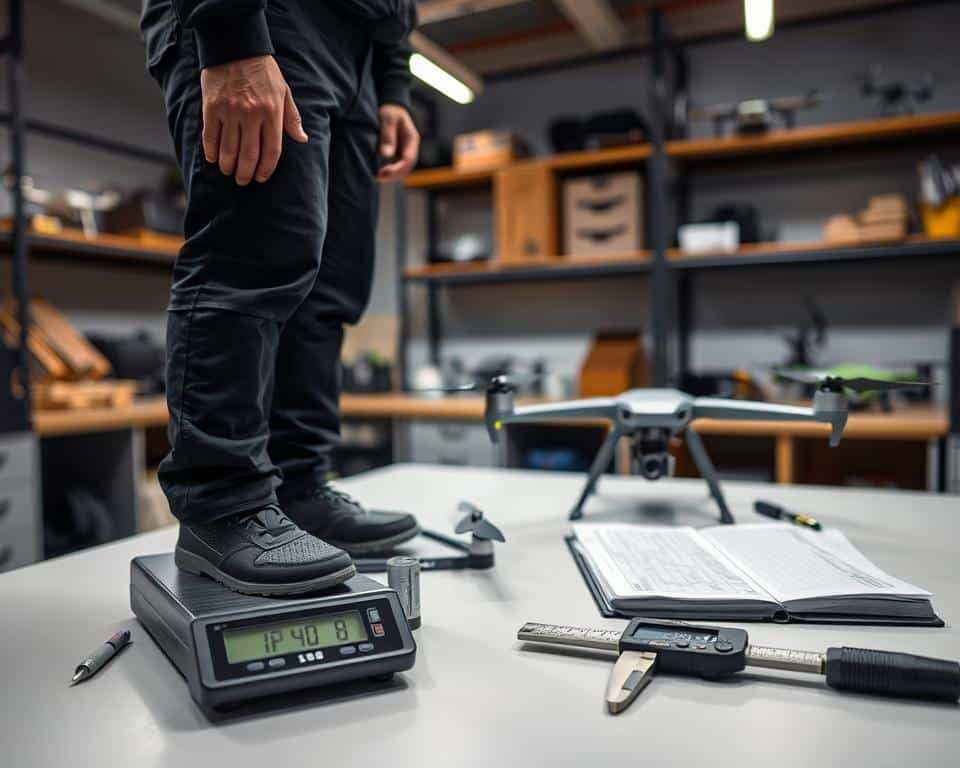
Proper Weighing Procedures for Regulatory Compliance
Use a precise digital scale to weigh your drone in its typical flying configuration. Include the aircraft itself plus any permanently attached components like cameras, gimbals, or sensors that are integral to normal operation. Removable batteries are typically not included in the base weight calculation for registration purposes, though they must be considered for operational weight limits.
Weigh your drone before first flight and after any modifications. Place the drone on a stable, level surface and ensure the scale is calibrated correctly. Record the weight measurement immediately to maintain accuracy.
Consider seasonal factors that might affect weight, such as moisture or temperature changes. Regular weight checks help ensure continued compliance with your drone’s designated category.
Documentation Standards and Record Management
Drone documentation requirements include maintaining detailed records of your aircraft’s weight and any modifications. Keep records of the original manufacturer specifications, actual measured weights, and any equipment changes that could affect weight category classification.
Document all modifications with before and after weight measurements. Include dates, equipment details, and the reason for changes. Store these records in both physical and digital formats for easy access during inspections.
Maintain compliance documentation for at least three years. This includes registration certificates, weight verification records, and modification logs. Proper record keeping demonstrates your commitment to compliance and protects you during FAA inspections or incident investigations.
Penalties and Consequences for Non-Compliance with Weight Regulations
Understanding the consequences of non-compliance with weight regulations helps pilots avoid costly mistakes and legal troubles. The FAA takes drone weight requirements seriously and has established a clear enforcement framework. Compliance penalties serve as both punishment and deterrent for future violations.
The enforcement system works on multiple levels depending on the severity of the violation. Minor infractions might result in warnings or educational requirements. However, repeated or serious regulatory violations can escalate quickly to substantial financial penalties.
Financial Consequences for Unregistered Aircraft
Operating an unregistered drone carries significant financial risks. The FAA can impose fines up to $27,500 per violation for each unregistered aircraft. These compliance penalties apply every time you fly without proper registration.
Commercial operators face even stricter enforcement. Multiple unregistered drones can result in separate fines for each aircraft. The FAA has increased enforcement activities, especially targeting businesses that operate without proper certification.
Even simple mistakes like failing to display your registration number properly can trigger enforcement action. The penalties accumulate quickly when violations involve multiple flights or aircraft.
Serious Legal Violations and Criminal Charges
Criminal penalties apply when regulatory violations involve safety risks or illegal activities. These cases can result in fines up to $250,000 and three years imprisonment. The FAA pursues criminal charges for the most serious infractions.
Operating in restricted airspace or interfering with manned aircraft triggers criminal investigation. Using drones for illegal surveillance or drug trafficking also falls under criminal jurisdiction.
Federal prosecutors handle these cases through the Department of Justice. Even first-time offenders can face significant criminal penalties when public safety is at risk.
State and Local Weight-Related Drone Regulations
Beyond federal weight requirements, drone pilots must understand how state drone laws and local drone restrictions can create additional compliance challenges. These regulations often work alongside federal weight categories but may impose stricter limitations or unique requirements for specific aircraft weights.
Many jurisdictions use federal weight thresholds as starting points for their own rules. However, they frequently add extra layers of complexity that pilots must navigate carefully.
How State Laws May Affect Weight Requirements
State drone laws frequently establish additional weight-based restrictions around sensitive locations. These laws commonly target areas near airports, government buildings, schools, and critical infrastructure facilities.
Some states create stricter weight limits than federal regulations require. For example, certain states may prohibit drones over 2 pounds near state parks or require special permits for aircraft exceeding specific weight thresholds in designated zones.
State laws also often mandate additional insurance requirements based on drone weight. Heavier aircraft may trigger higher coverage minimums or specific liability protections that exceed federal standards.
Several states have enacted comprehensive drone legislation that includes weight-specific operating procedures. These state laws may require enhanced pilot training, additional certifications, or specialized equipment for heavier aircraft operations.
Local Municipality Restrictions and Weight Limits
Local drone restrictions vary significantly between cities and counties. Many municipalities establish weight-based prohibitions in public parks, downtown areas, or during special events.
Urban areas frequently impose stricter weight limits than surrounding regions. Some cities completely prohibit drone operations over certain weights in residential neighborhoods or commercial districts.
Local ordinances may require permits for heavier aircraft operations, even when federal regulations don’t mandate such requirements. These local regulations often include specific weight thresholds that trigger additional compliance steps.
| Jurisdiction Level | Common Weight Restrictions | Typical Requirements | Enforcement Authority |
|---|---|---|---|
| State Government | Enhanced limits near sensitive areas | Additional permits, insurance | State aviation departments |
| County Level | Park and recreation restrictions | Local registration, fees | County sheriff departments |
| City Municipal | Urban area weight limits | Special event permits | Local police departments |
| Special Districts | Complete weight-based bans | No-fly zone compliance | District security teams |
Practical Tips for Drone Pilots Managing Weight Compliance
Managing drone weight compliance effectively requires strategic planning and smart decision-making throughout your piloting journey. Successful weight management starts with understanding your operational needs and choosing equipment that aligns with regulatory requirements. The key is balancing performance capabilities with compliance obligations.
Smart drone pilots think beyond just meeting current requirements. They plan for future needs and potential equipment upgrades. This forward-thinking approach prevents costly mistakes and regulatory violations.
Selecting Aircraft Based on Mission Requirements
Effective drone selection tips start with defining your specific operational needs. Consider your primary use case before making any purchase decisions. Commercial photographers need different capabilities than delivery operators or inspection specialists.
Calculate the total system weight including all necessary accessories. This includes cameras, gimbals, sensors, and any specialized equipment. Always account for battery weight and how it affects your drone’s center of gravity during flight.
Stay well below weight thresholds when possible. This strategy provides flexibility for future equipment additions without crossing into more restrictive regulatory categories. Many experienced pilots choose aircraft that operate at 80% of their target weight limit.
Strategic Equipment Upgrades
Planning equipment upgrades requires careful weight calculations. Lightweight components often cost more but provide long-term operational benefits. Carbon fiber accessories and titanium hardware can significantly reduce overall system weight.
Document all modifications and their weight impact. Keep detailed records of component weights for compliance verification. This documentation proves invaluable during inspections or regulatory reviews.
Effective Payload Management Systems
Successful payload management begins with precise measurement tools. Invest in a quality portable scale for field operations. Pre-flight weight checks should become standard procedure for all payload missions.
Develop systematic procedures for payload operations. Create checklists that include weight verification steps and maximum payload calculations. Account for battery discharge effects on aircraft performance and handling characteristics.
Always maintain safety margins below maximum weight limits. Weather conditions and emergency situations may require additional performance reserves that exceed normal operational parameters.
Conclusion
Navigating drone weight compliance becomes straightforward once you understand the FAA’s structured approach to aircraft classification. Each weight category serves a specific safety purpose while providing pilots with clear operational boundaries.
Your success as a drone operator depends on accurate weight determination and proper certification. Whether flying a lightweight recreational drone or managing commercial operations, the right pilot certification summary ensures you meet all legal requirements.
The regulatory landscape continues evolving as drone technology advances. New aircraft designs and expanded commercial applications drive ongoing updates to weight-based rules. Staying informed about these changes protects your operations and maintains compliance.
Smart pilots develop systems for tracking their equipment specifications and certification status. Regular weight verification and documentation create a solid foundation for legal operations across all flight scenarios.
The investment in proper certification and registration pays dividends through reduced liability and enhanced operational capabilities. Airlines, delivery services, and inspection companies all rely on certified pilots who understand weight compliance requirements.
Moving forward, focus on building expertise within your chosen weight category while monitoring regulatory developments. The drone industry offers tremendous opportunities for pilots who maintain professional standards and regulatory compliance throughout their careers.

